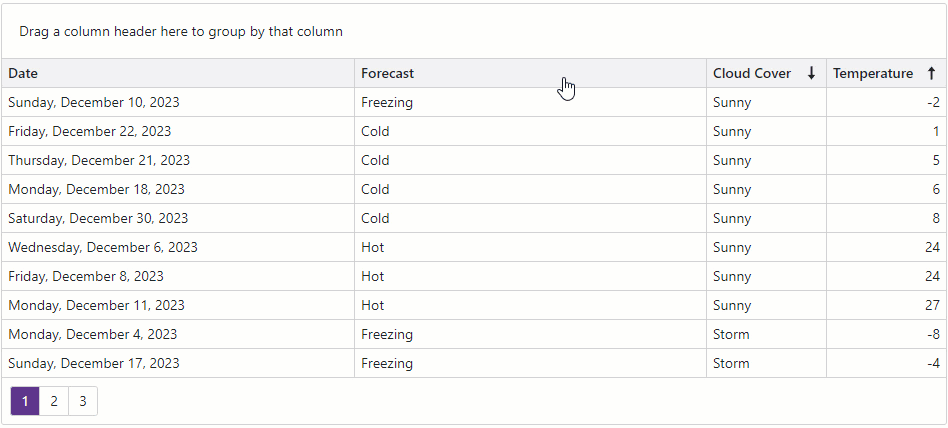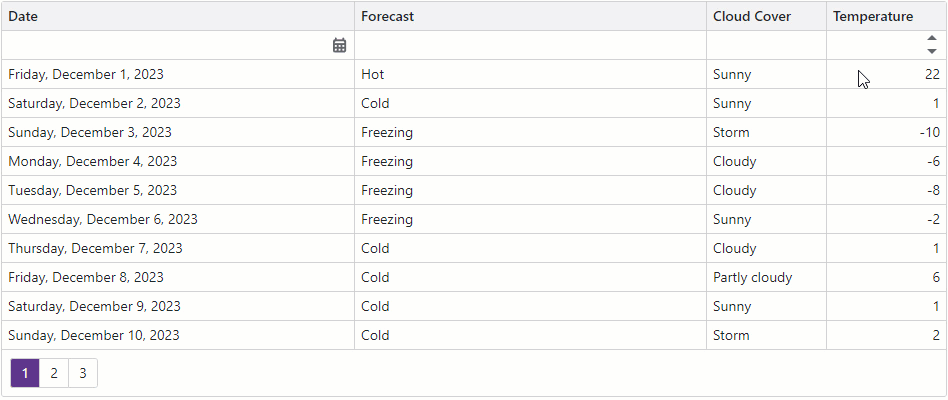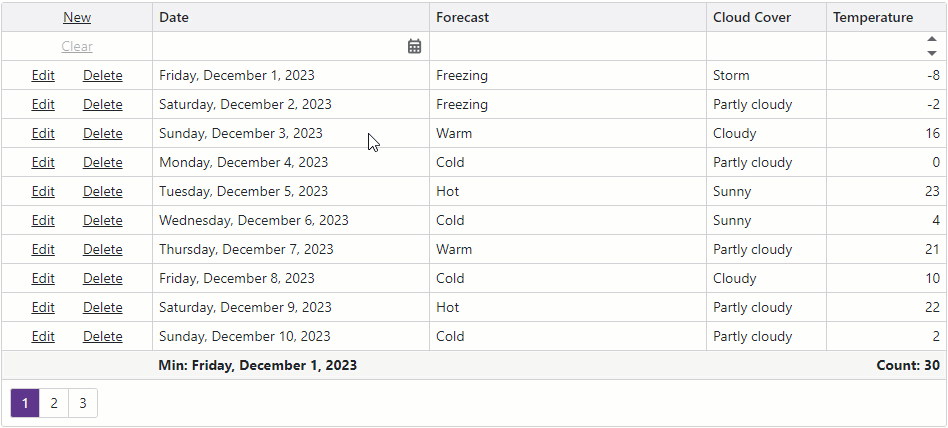Get Started with Blazor Grid
- 7 minutes to read
This tutorial describes how to build a simple Blazor application. The application uses a DevExpress Grid component to display and edit a weather forecast.

Create an Application
Refer to the following section for instructions: Create an application. Make sure that resources and themes are linked correctly.
Enable Interactivity on a Page
Blazor Grid supports static render mode to display static data in a single page. For other features, you need to enable interactivity on a Razor page and allow the Grid component to execute scripts and display data.
@rendermode InteractiveServer
Prepare a Data Source
Make sure your project includes the following classes:
- Data/WeatherForecast.cs
- Data/WeatherForecastService.cs
If you use Microsoft or DevExpress project templates to create a project, these classes are already included (you may need to change their code, see the next step). Otherwise, you should add the classes.
Use the following code for the classes:
using System; public class WeatherForecast { public DateTime Date { get; set; } public int TemperatureC { get; set; } public string Forecast { get; set; } public string CloudCover { get; set; } }Make sure that the
WeatherForecastServiceservice is registered in the Program.cs file.// ... builder.Services.AddSingleton<WeatherForecastService>();
Add a Grid and Bind It to Data
Add
<DxGrid></DxGrid>tags to the Pages/Index.razor page.@page "/index" <DxGrid> </DxGrid>Inject the
WeatherForecastServiceto the page.@page "/index" @inject WeatherForecastService ForecastService <DxGrid> </DxGrid>In the
@codeblock, declare a list ofWeatherForecastobjects –Data. Populate this list in the OnInitialized lifecycle method.@code { List<WeatherForecast> Data { get; set; } protected override void OnInitialized() { Data = ForecastService.GetForecast(); } }Use the Data property to bind the Grid to the
Datalist.<DxGrid Data="@Data"> </DxGrid>
Add Columns
- Add
<Columns></Columns>to the component’s markup to define the Columns collection. Add DxGridDataColumn objects to the
Columnscollection. Use the FieldName property to bind columns to data source fields (Date,Forecast,CloudCover,TemperatureC). Note that the FieldName property value must be unique for each data column.You can also set up the following properties to customize the columns:
- Caption
- Specifies the column’s caption.
- DisplayFormat
- Specifies the format of column values and summary values calculated for this column.
- Width
- Specifies column width in CSS units.
- FixedPosition
- Allows you to anchor the column to the Grid’s left or right edge.
<DxGrid Data="@Data">
<Columns>
<DxGridDataColumn FieldName="Date" DisplayFormat="D" />
<DxGridDataColumn FieldName="Forecast" />
<DxGridDataColumn FieldName="CloudCover" Width="120px" />
<DxGridDataColumn FieldName="TemperatureC" Caption="Temperature" Width="120px" />
</Columns>
</DxGrid>

Sort Data
You can execute the following operations to sort data in the grid:
- Click the Temperature column header to sort data against this column.
- Hold the Shift key and click Temperature and Cloud Cover column headers to sort data against these columns.
- Hold the Ctrl key and click column headers to clear sorting.

You can use SortOrder and SortIndex properties to specify initial sort settings.
<DxGridDataColumn FieldName="CloudCover"
Width="120px"
SortOrder="GridColumnSortOrder.Descending"
SortIndex="1" />
<DxGridDataColumn FieldName="TemperatureC"
Caption="Temperature"
Width="120px"
SortOrder="GridColumnSortOrder.Ascending"
SortIndex="0" />

Group Data
Set the ShowGroupPanel property to true to enable users to group data.
<DxGrid Data="@Data"
...
ShowGroupPanel="true">
</DxGrid>
To group data by a column, a user should drag and drop a column header onto the Group Panel.

You can also use the GroupIndex property to specify initial group settings.
<DxGridDataColumn FieldName="Forecast"
GroupIndex="0" />

Filter Data
Set the ShowFilterRow property to true to enable users to filter data.
<DxGrid Data="@Data"
...
ShowFilterRow="true">
</DxGrid>

Add Total Summary
Blazor Grid allows you to add total and group summaries. For example, follow the steps below to create the total summary.
- Add
<TotalSummary></TotalSummary>to the component’s markup to define the TotalSummary collection. - Add DxGridSummaryItem objects to the
TotalSummarycollection and specify their properties (SummaryType, FieldName, and so on).
<DxGrid Data="@Data"
... >
...
<TotalSummary>
<DxGridSummaryItem FieldName="Date"
SummaryType=GridSummaryItemType.Min
ValueDisplayFormat="D" />
<DxGridSummaryItem FooterColumnName="TemperatureC"
SummaryType=GridSummaryItemType.Count />
</TotalSummary>
</DxGrid>

Edit Data
Follow the steps below to allow users to edit data:
Declare a DxGridCommandColumn object in the
Columnscollection. The command column contains buttons that allow users to edit and delete rows.<DxGrid Data="@Data"> <Columns> <DxGridCommandColumn Width="150px"/> @* declare other columns *@ </Columns> </DxGrid>Set the EditMode property to
EditRowto use inline editors for data editing. In this mode, the Grid automatically generates editors for columns based on their data types.<DxGrid Data="@Data" EditMode="GridEditMode.EditRow"> <Columns> @* declare columns *@ <Columns> <TotalSummary> @* add summary items *@ </TotalSummary> </DxGrid>Implement handlers for the following events to post the changes to the data source:
<DxGrid Data="@Data" EditMode="GridEditMode.EditRow" EditModelSaving="OnEditModelSaving" DataItemDeleting="OnDataItemDeleting"> <Columns> @* declare columns *@ <Columns> <TotalSummary> @* add summary items *@ </TotalSummary> </DxGrid> @code { // ... void OnDataItemDeleting(GridDataItemDeletingEventArgs e) { Data.Remove(e.DataItem as WeatherForecast); } void OnEditModelSaving(GridEditModelSavingEventArgs e) { var editModel = (WeatherForecast)e.EditModel; var dataItem = e.IsNew ? new WeatherForecast() : (WeatherForecast)e.DataItem; dataItem.Date = editModel.Date; dataItem.TemperatureC = editModel.TemperatureC; dataItem.CloudCover = editModel.CloudCover; if (e.IsNew) Data.Add(dataItem as WeatherForecast); } }

Tip
For detailed information on how to enable data editing and use edit-related options, refer to the following topic: Editing and Validation in Blazor Grid.
Complete Code
@page "/index"
@inject WeatherForecastService ForecastService
<DxGrid Data="@Data"
ShowGroupPanel="true"
ShowFilterRow="true"
EditMode="GridEditMode.EditRow"
DataItemDeleting="OnDataItemDeleting"
EditModelSaving="OnEditModelSaving">
<Columns>
<DxGridCommandColumn />
<DxGridDataColumn FieldName="Date"
DisplayFormat="D" />
<DxGridDataColumn FieldName="Forecast"/>
<DxGridDataColumn FieldName="CloudCover"
Width="120px"
SortOrder="GridColumnSortOrder.Descending"
SortIndex="1" />
<DxGridDataColumn FieldName="TemperatureC"
Caption="Temperature"
Width="120px"
SortOrder="GridColumnSortOrder.Ascending"
SortIndex="0" />
</Columns>
<TotalSummary>
<DxGridSummaryItem FieldName="Date"
SummaryType=GridSummaryItemType.Min
ValueDisplayFormat="D" />
<DxGridSummaryItem FooterColumnName="TemperatureC"
SummaryType=GridSummaryItemType.Count />
</TotalSummary>
</DxGrid>
@code {
List<WeatherForecast> Data { get; set; }
protected override void OnInitialized() {
Data = ForecastService.GetForecast();
}
void OnDataItemDeleting(GridDataItemDeletingEventArgs e) {
Data.Remove(e.DataItem as WeatherForecast);
}
void OnEditModelSaving(GridEditModelSavingEventArgs e) {
var editModel = (WeatherForecast)e.EditModel;
var dataItem = e.IsNew ? new WeatherForecast() : (WeatherForecast)e.DataItem;
dataItem.Date = editModel.Date;
dataItem.TemperatureC = editModel.TemperatureC;
dataItem.CloudCover = editModel.CloudCover;
if (e.IsNew)
Data.Add(dataItem as WeatherForecast);
}
}
More Features
For more information about Grid features, refer to the root topic.